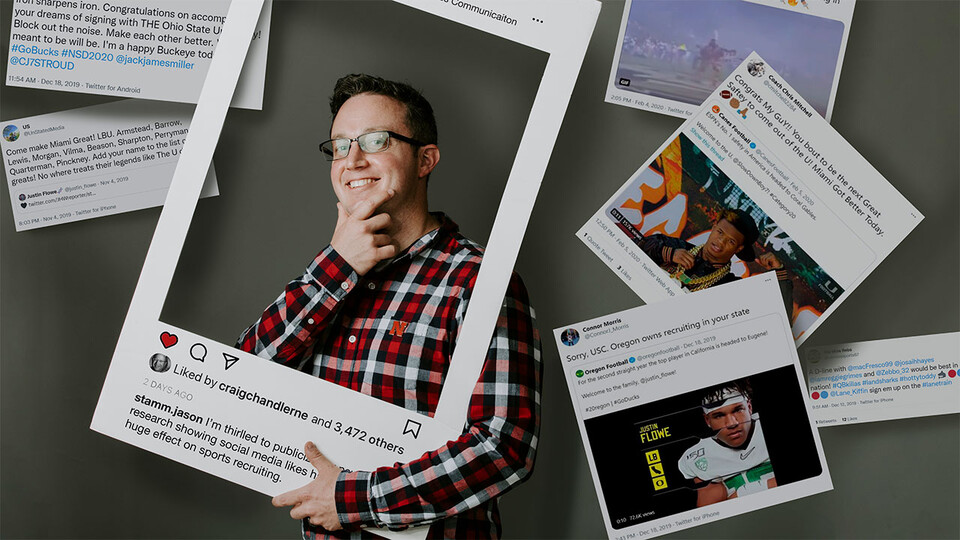· 7 min read
A thin (yard) line: Twitter reveals football fans’ love-hate stance on recruits

It’s his loss. It was never going to work, anyway. Those two deserve each other.
Think losing out on love is a blow to the ego? Try a five-star quarterback.
Because if the recruitniks on Twitter are any indication, it might be better never to have loved at all.
That’s one of multiple takeaways from a new study co-authored by the University of Nebraska–Lincoln’s Jason Stamm. The research details how college football fans attempt to woo blue-chip recruits on Twitter — and how those fans react when recruits either commit to giving their program a shot or squash any hope of a long-term relationship.
College football fandom has long been recognized as a reflection and amplification of a broader social identity. Prior studies, for instance, have shown that college students wear their team’s apparel more often after a win than a loss. Other clichés of the fickle fan — When the team wins, it’s “we,” when the team loses, it’s “they” — are backed by research, too.
But social media has given fans unprecedented access to, and visions of grandeur regarding the fates of, touted high school athletes who frequently document their recruiting process there, Stamm said.
“They put everything on Twitter — when they have a top 10 (list of schools), a top 3, when they go visit somewhere,” said Stamm, assistant professor of sports media and communication at Nebraska and a longtime writer for the recruiting outlet Rivals.com. “And they get this long line of replies, for everything they do, from just random fans.”
In those tweets, Stamm and Clemson University’s Brandon Boatwright saw an opportunity to better understand the psyche of the plugged-in, very online college football fan.
“We knew there was a lot of social identity involved with why fans would be doing this, what they would be getting out of it,” Stamm said.
The duo took it upon themselves to analyze 8,160 fan-composed tweets that tagged at least one of five blue-chip football recruits in the two months before their commitments and the two days after. (Those recruits would wind up committing to LSU, Miami, Ohio State, Oregon and Texas A&M, respectively.)
The researchers started by codifying the ways that Twitter users tried to recruit on behalf of their schools. In many cases, they essentially just pleaded for the recruit to commit: begging, ingratiating themselves, predicting big things if the recruit would just make the right choice. Other times, the fans name-dropped their programs’ current or past star players, coaches, celebrity fans — sometimes tagging them, too — in an effort to persuade a recruit.
Some Twitter users took the opportunity to trash-talk fans of other programs who had been tweeting at a recruit. Occasionally, a fan would — out of despair or possibly in an attempt at reverse psychology — concede that their school had little chance. A small percentage trolled the recruits, taking aim at their supposed narcissism or lack of talent.
But, as Stamm put it, “you really get to see the true fan” when the verdict comes in. Taking a cue from some seminal research on fandom and social identity, Stamm and Boatwright filtered fan reactions through two lenses: basking in reflected glory, if the recruit committed to a fan’s school, or cutting off reflected failure, if the recruit chose another.
By associating with a prominent person or organization — in this case, a blue-chip recruit who commits to a fan’s school — the fan receives a vicarious boost to their sense of self, according to the basking framework.
“Basking in reflected glory is basically a confirmation of my fandom,” Stamm said. “‘We’re good enough for this recruit that I’ve wanted for so long. I cannot wait for the season to start.’”
That basking took multiple forms on Twitter. Fans often touted their affiliation with the program and framed the commitment as a group accomplishment. They fantasized about the program’s future, projecting success for both the commit and the team. They boasted about the program’s capacity to mold a commit into a star or elevate his personal brand. And, naturally, some gloated, couching the decision as a victory over rival programs.
As for when the decision went against their school? A substantial, maybe surprising proportion of fans took the high road, Stamm said.
“‘I’m happy for you because I’m a good human being, and I still want to see you be successful,’” Stamm said in characterizing those reactions. “‘I realize you are a 17-, 18-year-old kid. I want to see you have success.’
“You do get a lot of people who are mindful of: These are minors. They’re not adults yet, most of them. And it’s their decision; it’s their life. You’re not going to make everybody happy, right? You can’t go to every school. If I’ve got 30 schools recruiting me, I can only pick one of them. I can’t go to all 30.
“And then there are the other people.”
Those other people, Stamm said, tend to indulge the dark side of cutting off reflected failure. Their allegiance to the team can take a petty precedence over a one-sided relationship that they may have cultivated over several years but ultimately saw unrequited — the dashing of hope, in a sense, for a long-held crush.
“It’s a punch in the gut, I think, for a lot of people who are really that invested in a recruit,” Stamm said.
In some instances, fans simply lamented the loss of a potential commitment as they might a loss on the field, expressing disappointment or blaming a coach for the outcome. But others responded by minimizing the importance of the decision: “Where he will probably not be developed & will wind up the trash heap that The U is accustomed to. Have a nice day,” went one.
Some went further, pulling an about-face by belittling the very athlete they had so coveted just a day earlier. In those cases, hell hath no fury like a recruitnik scorned.
“I think those are fans who say, ‘Nope, you’re making me feel bad. It’s a bad look for my team, for my personal identity, my social identity,’” Stamm said. “‘You’re not good enough for me. Go suck somewhere else.’”
To Stamm, the most surprising finding actually came by way of the recruits themselves: Not once, given 8,160 chances, did they reply to a tweet in which they were tagged. Though he expected that Twitter traffic to flow mostly in one direction, Stamm wasn’t anticipating such deafening digital silence. Still, he said, it’s hardly the first example of media consumers developing relationships in the absence of a dialogue.
“It’s the perception that a person has purely based on one-way communication,” he said, comparing it to the viewer who watches the same local TV news anchor for years. “I’m not communicating with you, but from watching you — seeing how you talk, how you react, your humor — I feel like I know you.”
So, why the silence? Stamm isn’t sure, but he suspects it might have to do with the emergence of name-image-likeness, or NIL, opportunities that went into effect this summer and allow student-athletes to profit from their performance.
It might well be the case, he said, that there is just more to lose than gain by engaging with fans on Twitter, even those who seem to have the best intentions. College student-athletes at many major schools already receive guidance on using social media. It’s beginning to look like blue-chip high schoolers are also receiving advice, Stamm said. If so, it seems to be saying: Silence is golden.
“I think there’s definitely some connection between name-image-likeness,” he said, “and the way these high school recruits are handling themselves on social media.
“They’re really trying to keep that brand, I think, intact. But we want to interview them to see exactly what they’re thinking.”









